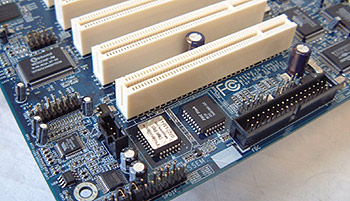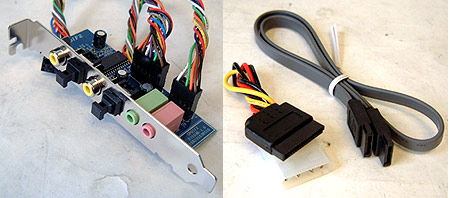The i865PE, CSA and ICH5R
 Probably the most obvious feature I dislike about the PX865PE Pro II is the
location of the floppy drive connector. Located at the very bottom of the PCB
means that users with full tower cases like the AOpen HX08 or Inwin Q500 will
have a difficult time getting their floppy drive connected. It also means that
you'll have to wrap the FDD cable around your other system devices which can
create hot spots.
Probably the most obvious feature I dislike about the PX865PE Pro II is the
location of the floppy drive connector. Located at the very bottom of the PCB
means that users with full tower cases like the AOpen HX08 or Inwin Q500 will
have a difficult time getting their floppy drive connected. It also means that
you'll have to wrap the FDD cable around your other system devices which can
create hot spots.
It would have been nice for Albatron
to place all the headers near the edges of the motherboard as this makes
things easier for the end user. With some of the headers where they are now,
they could interfere with some PCI devices.
Perhaps I'm being a bit too picky
here but something else I would have liked to see are more USB ports on
the back panel. Yes there is an accompanying four port USB riser but personally
two leaves me feeling a bit bare.

The i865PE Springdale:

The i865PE is Intel's new mainstream chipset and it
brings a whole slew of new features to the mainstream Pentium 4 users; most
notable are 8x AGP, Dual Channel DDR and CSA. 8x AGP provides the videocard with
up to 2.1 GB/s worth of bandwidth which doubles the amount of data that can be
sent to the videocard. While real world performance has not gotten any
significant performance gain due to 8x AGP, it has potential and may be
important in the future when games rely more heavily on the AGP bus.
Looking
back, the fatal flaw of the i845 DDR chipsets were, they
could never provide enough memory bandwidth to keep the Pentium 4 processor
happily fed because they only have a single DDR memory channel. Even the last
i845 introduced could only provide a 400 MHz based Pentium 4 processor 2.1 GB/s
of bandwidth and a 533 MHz based P4 2.7GB/s of bandwidth. A far cry from the 3.2
GB/s bandwidth required for the 400 MHz processors and 4.2 GB/s for the 533 MHz
chips.
With the i865PE, there are now two memory channels
that work in parallel thus doubling the bandwidth available to the processor.
For instance a 533 MHz based Pentium 4 needs 4.2 GB/s of bandwidth to be happy,
if you use run two PC2100 DIMM's in parallel they offer exactly 4.2 GB/s (memory
channel 1 2.1 GB/s + memory channel 2 2.1 GB/s) of bandwidth when running at 133
MHz FSB. An 800 MHz based Pentium 4 needs 6.4 GB/s and running dual channel DDR
400 memory will provide that required 6.4 GB/s. The Pentium 4 is no longer
bandwidth starved when running with the i865PE.

Communications Streaming
Architecture:
Gigabit Ethernet is nothing new to the world of
computers and while some of the motherboards we tested in the past had this
option, one of the potential problems that may arise is when a Gigabit
connection is running at full speed (full duplex, 2Gb/s or 250MB/s), it has the
potential to saturate the PCI bus and leave little or nothing for the other
devices. What a perfect place to introduce the new CSA
bus!
CSA stands for
Communications Streaming Architecture and what it does is give the Gigabit Ethernet controller a
direct 16 bit link to the MCH (Memory Controller Hub). The maximum bandwidth
available on the CSA is 266 MB/s, just a tad more then the maximum 250 MB/s (Full
Duplex) can produce.
Intel
being Intel, the
company naturally has a patent over CSA technology and may license this out. It's up
to chip manufacturers to see if they want to
adopt and potentially pay the extra fee for a CSA NIC. The Albatron PX865PE
Pro II does use an Intel 82547EI CSA Gigabit Network Adapter.
 One
of the most significant features Intel have implemented on the new ICH5
southbridge is native Serial ATA support. Now that two
Serial ATA headers are integrated into the ICH5 southbridge yet another
bottleneck is removed. The theoretical maximum bandwidth of Serial ATA currently
is 150MB/s, and as you can see this is more than the 133MB/s the PCI bus offers
(yes I know that current drives will not reach that speed). One
of the most significant features Intel have implemented on the new ICH5
southbridge is native Serial ATA support. Now that two
Serial ATA headers are integrated into the ICH5 southbridge yet another
bottleneck is removed. The theoretical maximum bandwidth of Serial ATA currently
is 150MB/s, and as you can see this is more than the 133MB/s the PCI bus offers
(yes I know that current drives will not reach that speed).
If one were to run Gigabit LAN, Serial ATA HDD's
and say... some other high bandwidth devices like an external IEEE 1394 HDD, the
PCI bus could be saturated very quickly.
The ICH5 supports two Serial ATA channels as well
as two parallel IDE channels for a total of six possible drives (one drive per
SATA channel). The ICH5 also increases the number of USB2.0 ports from four to
eight.
As you probably noticed, we said the AOpen AX4SPE
Max uses the ICH5R southbridge, and the 'R' stands for RAID. Initially, the ICH5R only supported RAID 0
(stripping), but Intel is working on including RAID 1 as well and all that is
required is for the end user to flash their motherboard with a newer BIOS.
Normally if you want to make any changes to a RAID
setup, it would require you to format and reinstall your software. Intel has
made life a bit easier for the end user, if you get a second HDD of the same
size and would like to take advantage of the RAID 0 setup, simply use the Intel
Application Accelerator software to use RAID 0 on both your drives! Please keep
in mind, this is for Serial ATA only.
|
